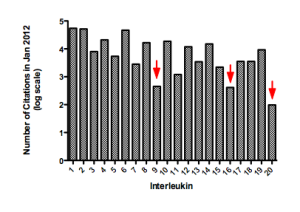The interleukins are an odd family. One name encompasses dozens of secreted proteins that are linked by function rather than by structure. And even that common function is very broadly defined: cytokines that communicate between cells of the immune system.
Defined in such a way, its perhaps not surprising that the interleukins have yielded some of the best biomarkers of inflammatory disease conditions, and even more importantly are the target for a growing range of antibody therapeutics. Interfering with interleukins is to biologicals what GPCRs are to small molecule drugs.
As with GPCRs, though, despite the success of interleukins as biomarkers and drug targets, some members of the superfamily are extensively studied and well understood, while others lie on the periphery largely ignored. Type interleukin-1 into PubMed and it returns a staggering 54690 papers. Repeat the exercise for the rest of the interleukins and you make an interesting discovery: although there is a slight downward trend across the family (probably reflecting the decreasing time since each was first described), there are a couple of striking outliers (Figure 1). Family members who are much less well studied than the rest. IL-9 has only 451 citations, IL-16 has 414 and IL-20 just 98.
 Are they really less interesting? Or does this just reflect the positive re-enforcement of previous publications? Once one paper links a particular interleukin with a disease or physiological process, a crop of papers exploring that link quickly appear, casting in concrete the random process of discovery. If that’s correct, these unloved interleukins might make excellent targets for research and drug discovery.
Are they really less interesting? Or does this just reflect the positive re-enforcement of previous publications? Once one paper links a particular interleukin with a disease or physiological process, a crop of papers exploring that link quickly appear, casting in concrete the random process of discovery. If that’s correct, these unloved interleukins might make excellent targets for research and drug discovery.
Take IL-9 for example: what little is known about this cytokine certainly doesn’t paint a picture of a backwater function undeserving of attention. IL-9 is a product of CD4+ T cells (probably one of the Th2 group of cytokines that includes the much-studied IL-4 and IL-5) that promotes proliferation and survival of a range of haemopoietic cell types. It signals through the janus kinases (jaks) to modulate the stat transcription factors (both of which are validated drug targets in inflammatory diseases). Polymorphisms in IL-9 have been linked to asthma, and in knockout animal studies the gene has been shown to be a determining factor in the development of bronchial hyper-reactivity.
IL-16 looks no less interesting. It is a little known ligand for the CD4 protein itself (CD4 is one of the most extensively studied proteins in all of biology, playing a key role on helper T cells, as well as acting as the primary receptor for HIV entry). On T cells, which express the T Cell Receptor (TCR) complex, CD4 acts an important co-stimulatory pathway, recruiting the lck tyrosine kinase (a member of the src family, and itself and interesting drug target being pursued by, among others, the likes of Merck). But CD4 is also expressed on macrophages, in the absence of the TCR, and here it is ligand-mediated signaling in response to IL-16 that is likely to be the dominant function.
Another interesting feature of IL-16 is the processing it requires for activity. Like several other cytokines, such as TGF-beta, IL-16 needs to be cleaved to have biological activity. For IL-16 the convertase is the protease caspase-3, which is the lynchpin of the apoptosis induction cascade, tying together cell death and cell debris clearance.
Like IL-9, polymorphisms in the human IL-16 gene have also been associated with chronic inflammatory diseases, including coronary artery disease and asthma. But perhaps the most interesting observations relating to IL-16 come from biomarker studies. Our own studies at Total Scientific in our extensive range of preclinical models of chronic inflammatory diseases have repeatedly found IL-16 to be the best marker of disease activity. In human studies, too, IL-16 levels in both serum and sputum have been associated with inflammatory status, particularly in asthma and COPD but also in arthritis and IBD.
After years in the backwater, perhaps its time for the ‘ugly ducklings’ of the interleukin family to elbow their way into the limelight. After all, the rationale for adopting either IL-9 or IL-16 as a diagnostic biomarker, or even as a target for therapeutic intervention, is as good as the case for the better known interleukins. But the competition is likely to be less intense.
Many years ago, the Nobel laureate Arthur Kornberg, discoverer of DNA polymerase, once said “If, one night, you lose your car keys, look under the lamppost – they may not be there, but it’s the only place you have a chance to find them”. Sound advice – unless, of course, there are twenty others already searching in the pool of light under the lamppost. Maybe the twinkle of metal in the moonlight may be your chance to steal a march on the crowd.
Dr. David Grainger
CBO, Total Scientific
Read the original article here
RxCelerate Ltd is an outsourced drug development platform based near Cambridge, UK. We specialize in delivering an entire road map of drug development services from discovery and medicinal chemistry through to formal preclinical development and clinical up to Phase IIa. In the last five years, we have witnessed dramatic changes in the drug development …
